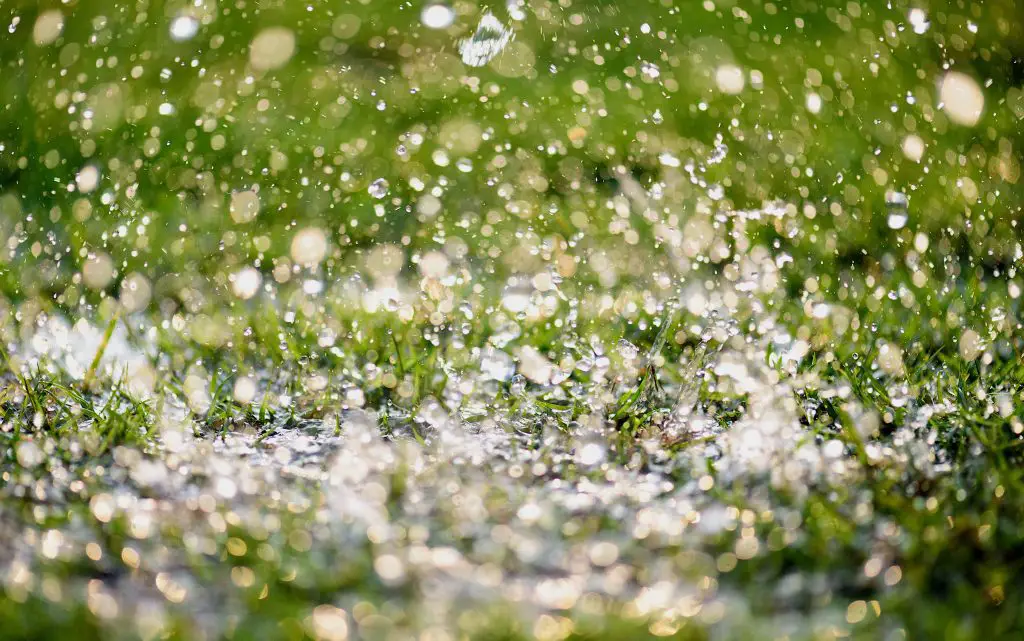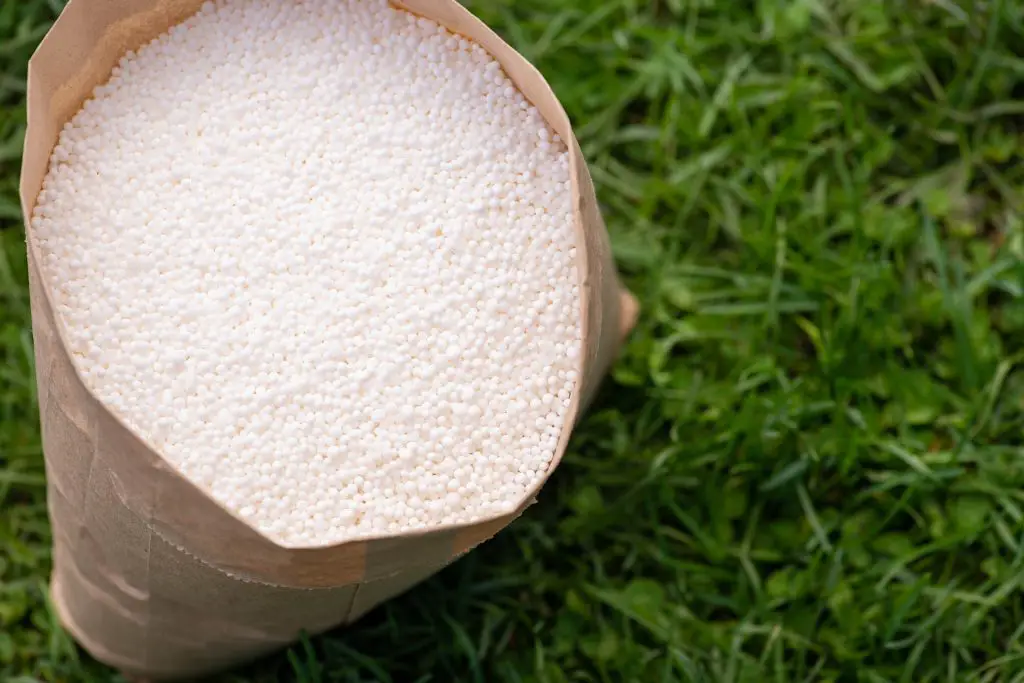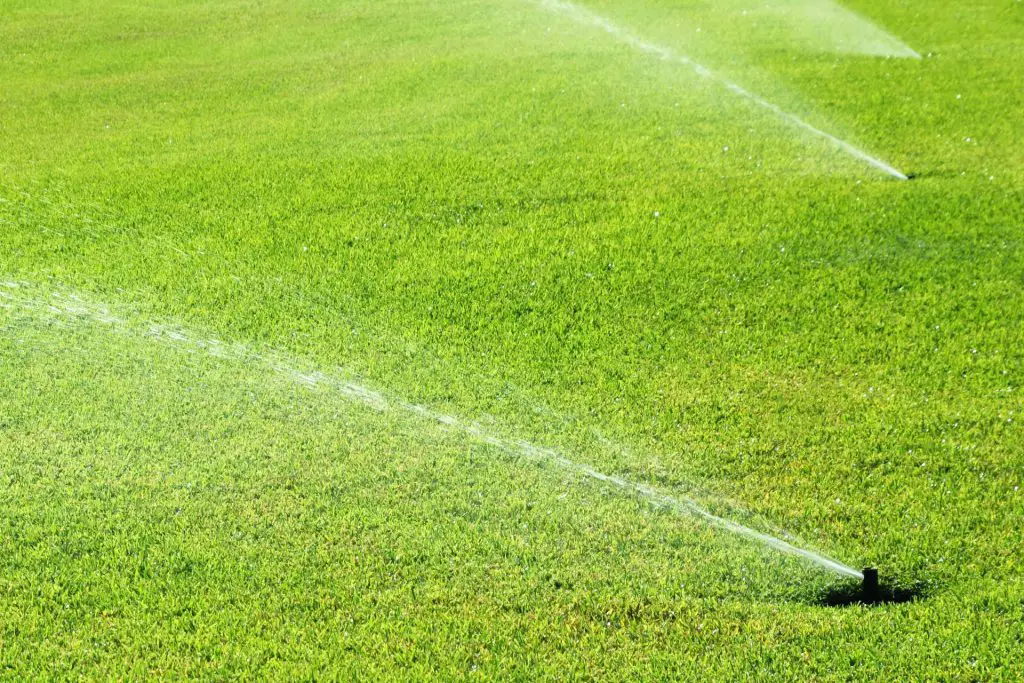Should a little rain stop you from fertilizing your lawn? Can You Apply Fertilizer to Wet Grass?
Fertilizing your lawn is an important part of a good lawn care program for ensuring a thriving lawn, but getting the process wrong can also be detrimental to the health of your lawn. Heavy rain and saturated turf are two complications that need to be considered when you fertilize as they can throw off the balance of nutrient levels in your garden.
Of course, a certain amount of moisture is needed in the soil as it is often necessary to enable some fertilizer types to work. This raises the question of how much moisture there should be. If the ground becomes too saturated or the grass blades are wet then there can be detrimental effects. Factors such as weather, the type of fertilizer employed, and timing will therefore affect your fertilizing program.
You should avoid applying fertilizer if your grass blades are wet, there is standing water on your lawn, or if you are expecting heavy rain or strong winds. Ideally, you should water deeply prior to fertilizing but allow enough time for the grass blades to dry out before application. You should give the fertilizer time to settle before watering again.
How Wet Is the Grass

What do we mean by wet grass? In normal circumstances applying fertilizer to damp soil but dry blades helps the fertilizer in the dissolving process. However, if the lawn is saturated, has surface water or the grass blades are wet then this can be become a problem. How detrimental, would depend on factors such as the kind of fertilizer you are using, slope gradients, and potential runoff.
If your soil is slightly damp from your irrigation schedule or from morning dew it should be fine and possibly advantageous to apply fertilizer, although you shouldn’t apply fertilizer if the grass blades themselves are wet.
In terms of watering, generally, it is always advisable to water long and deep rather than shallow and often. If preparing to fertilize, it would be good to do this the day prior to your fertilizer application, allowing the soil to remain damp but for the blades to have dried out. After application, you should only lightly water after allowing the fertilizer to settle for a few days.
Weather
Weather will obviously play an important role in the amount of moisture content present in your grass and thus the timing of your fertilizer application. It can affect it in a number of ways, mostly in terms of rainfall and wind.
Rainfall
One of the most commonly asked questions is whether should you fertilize before or after rain. Unless you can accurately forecast the timing, extent, and intensity of the rainfall it is always advisable to wait until after. If you know or are expecting light rain in the next few days then it is fine to fertilize before, but if the rain becomes heavy and intense you could run into some of the issues that we will discuss below.
Drought
The flip side of the argument is if you are suffering from a period of drought or extremely arid conditions you should also hold off fertilizing. This is because the grass needs to be fully hydrated in order to take up the nutrients. If it is not, then there will be less nutrient uptake and this in turn could lead to excess nutrients remaining in the soil. This in turn could damage the grass as fertilizer, left on extremely dry grass, can burn.
Timing
The final weather-related issue is timing. You will often hear that late fall is the best time of year to fertilize and there is some truth in this. The weather is often kinder, but there is still good sunshine to help the photosynthesis process, essential for processing nutrients. However, you may need to fertilize several times over the course of your grasses growing season and whether you have warm-season grass or cool-season grass can have an impact on timing.
Why Fertilizing Wet Grass Is a Bad Idea

If fertilizer is applied to wet grass there are several different problems that can occur. Water helps fertilizer break down into its nutrient components the main three being nitrogen, phosphorus, and potassium. But this should be a controlled process and excess water can result in leaching. Beyond the loss of nutrients into the water, This can also have serious environmental consequences.
Nutrient Depletion
As we have just touched on, the first and most obvious reason why you shouldn’t fertilize wet grass is the loss of nutrients. If you apply fertilizer to wet grass it will actually lose nitrogen the water in your lawn leaches the nutrient out of the fertilizer, while at the same time inhibiting the ability of phosphorous to be released1.
In addition, rainwater quickly dilutes fertilizers and washes them away or leaches out some of the key nutrients, preventing the lawn from absorbing as much of the fertilizer as if it were dry.
Uneven Fertilizer Distribution
Following on from possible nutrient deficiency can result in uneven nutrient distribution. Heavy rain and wind can lead to the coalescing of granules and nutrients in the soil.
Together with any leaching, you can end up in a situation where some areas of your lawn may be deficient in fertilizer, while others will have too much. This can lead to an overall imbalance in the soil’s nutrient composition and fertility.
Excessive Fertilization of Your Grass
A consequence of this can be the over-fertilization of your lawn. This is because in the mistaken belief that all the fertilizer has been washed away another fertilizer application is administered.
The wet grass and weather can lead to the fertilizer having become poorly distributed, which, on its own, can then burn the grass where too much has coalesced. Adding a further application of fertilizer in the belief that it has all washed away is likely to exacerbate the issue in these areas.
In these circumstances, even a soil test to determine the proper fertilizer percentage may prove unreliable. As the fertilizer has become unevenly spread you are likely to get inconsistent readings. This can cause you to over or under-fertilize your lawn in different areas, both of which can be detrimental to the health of your grass.
Runoff: Contamination of Water Sources
A wider issue is that fertilizing wet grass can have a negative impact on the environment. If your fertilizer gets washed away by heavy rainfall or blown away it can contaminate nearby water sources. This is because the runoff will contain elevated levels of nitrogen and other minerals that eventually find their way into rivers and waterways, where it can cause harm to fish and other wildlife.
Different Lawn Fertilizer Types Used on Wet Grass

There are, of course, differences in how heavy rain or overly saturated grass can impact different types of fertilizer. Some types of fertilizer can cope better in these conditions than others.
Quick-Release Fertilizers
When you apply these types of fertilizers, the nutrients will be released immediately. The main benefit of this is that it gets absorbed quickly by the roots and gets distributed to other parts of the plant. It is therefore used when seeding a lawn or if you want to give a quick boost to a lawn.
However, when you apply too much fertilizer to wet grass, it can damage your grass as well as surrounding plants and soil because of its high concentration of nitrogen. It is susceptible to the same problems that all granular fertilizers will have in that it can leach or be washed away as runoff during rain storms.
The effects will vary according to the type of fertilizer applied. Some quick-release fertilizers are less problematic than others due to their different chemical composition.
Slow-Release Fertilizers

This type of fertilizer is slower in releasing its nutrients. It’s also slower in absorbing into the soil. The chemicals may be released and absorbed at different rates depending on the types of plants, soils, and weather conditions. It is usually used on established lawns.
Although this type of fertilizer releases its nutrients far more slowly over time, it is still detrimental to apply it to wet grass. It can still leach, although to a lesser extent, and still be moved by wind and rain, with the subsequent uneven distribution and impact that can result.
Fertilizers in Granular Form
Both slow-release and quick-release fertilizers are often formulated and supplied in granular form. As we have noted applying solid granular fertilizer when it is raining, or to grass that is wet, is far from ideal. All granular fertilizer products have the potential to leach or wash away causing uneven distribution.
Liquid Fertilizers
Fertilizers don’t have to be granular, they also come in liquid form. Because of their physical state, they are designed to make nutrients readily accessible immediately after application. If these liquid fertilizer formulations are applied directly to wet grass, or just before it starts to rain, they are likely to become less effective or may be washed away entirely. The best time to apply liquid fertilizer is when the grass has dried up completely.
In terms of environmental impact, they share the same problems as those of using granular alternatives. Any runoff will still contain elevated levels of nutrients, and it could also lead to burning and discoloration of the blades too!
Organic Fertilizers
Natural fertilizers are organic and do not contain any synthetic ingredients. They can be in the form of simple grass clippings left on the surface of your lawn after cutting, the application of a fine particle compost, milorganite, or other organic materials.
They also come in a wide range of forms, such as granular, slow-release, pelletized, liquid, or even top dressings (a.k.a compost tea).
These can be easily applied but the downside is that they may require more time to become fully effective and will often produce mixed results at best if you apply them on wet grasses.
Summary:
Fertilizing your lawn as part of your lawn maintenance program is usually essential in ensuring you have a healthy green lawn. On the whole, applying fertilizers to damp ground, but dry grass blades, is the ideal scenario.
However, applying fertilizer when your grass is wet if the soil is sodden, or before a heavy rainstorm, it can be detrimental to your lawn’s health and to the environment. It will not receive the full benefit of fertilizer since rainwater intrudes upon fertilizers as they are being applied. This could lead to poor growth and lower yields for your lawn.
As we have noted this often results in overcompensation or a failure to realize that your lawn, or parts of your lawn, don’t possess the nutrient levels you think they should have.
Understanding the rhythm of your climate and your grass’s growing season together with good irrigation practices will ensure that your lawn fertilization maintains a thriving lawn.
Notes:
- United States Department of Agriculture: Soil Phosphorous ↩︎
